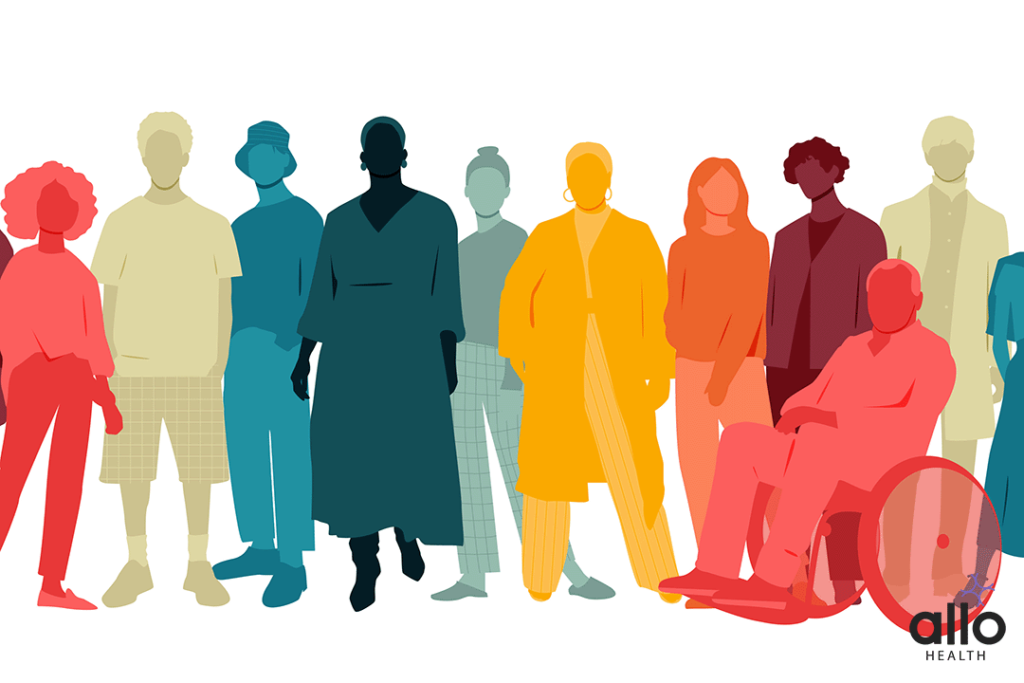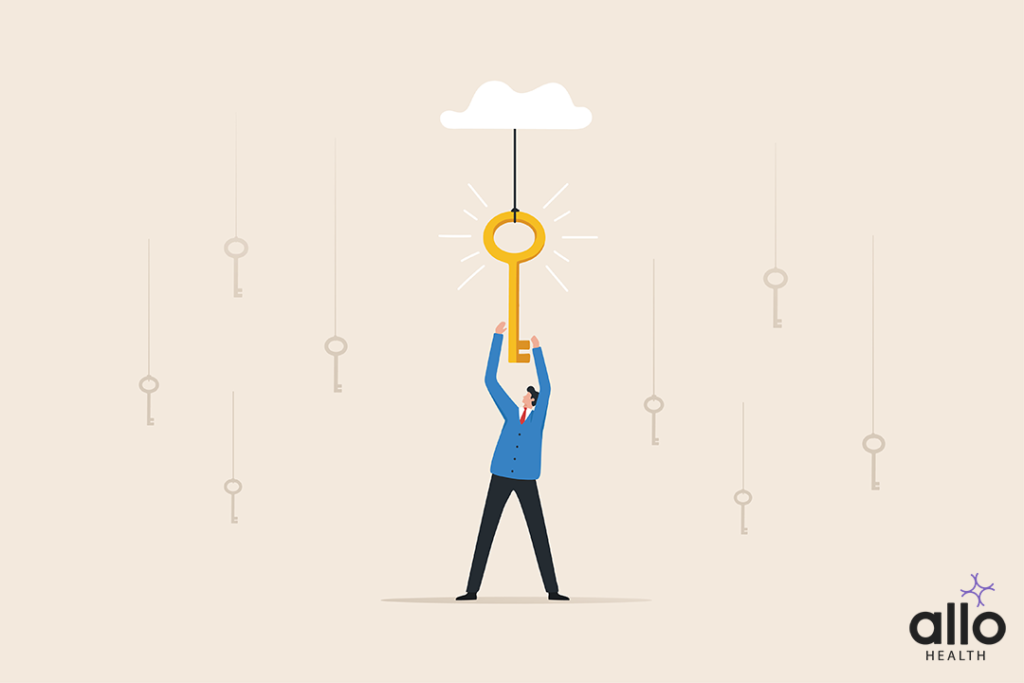LGBT History In India

Allo Health is dedicated to personalized well-being, offering support and trusted information tailored to individual health goals. The platform emphasizes human-generated content, led by a distinguished medical team of experts, including physicians and sexual health specialists. Their commitment to credibility involves rigorous fact-checking, authoritative research, and continuous updates to ensure accurate, up-to-date information. Allo Health's unique approach goes beyond conventional platforms, providing expert-led insights and a continuous commitment to excellence, with user feedback playing a crucial role in shaping the platform's authoritative voice.

A psychologist with clinical specialization and experience working with sub-clinical and clinical populations. Her areas of interest and expertise include anxiety-related disorders, mood disorders, psychotic disorders, addictions, sexual health and wellness, relationship issues, stress, and geriatric mental health.

Anoush Gomes is a seasoned Content Writer with over 10 years of experience, specializing in various writing styles such as medical content, creative writing, storytelling, and research papers. Anoush embarked on a unique journey, starting with pre-medical studies at the Dante Aligheri Academy and the University of Miami, where she earned a Bachelor's degree with a major in Biology and a minor in Psychology. Having pursued medical school and completed clinicals, Anoush transitioned to the world of medical content writing, where her passion for both healthcare and writing converged. Her writing skills encompass persuasive, narrative, expository, and descriptive styles, making complex medical concepts accessible to diverse audiences. Beyond her professional endeavors, Anoush is a multi-faceted individual with a rich tapestry of interests. A writer, artist, poet, avid reader, certified nerd, and hopeful author, she finds inspiration in the intersection of creativity and science. Whether crafting engaging medical narratives or weaving captivating stories, Anoush combines her diverse background and writing expertise to deliver compelling content that resonates with diverse audiences.
Why This Was Upated?
Our experts continually monitor the health and wellness space, and we update our articles when new information became available.
Updated on 03 November, 2023
- Article was updated as part of our commitment to diversity, equity, and inclusion.

"The following blog article provides general information and insights on various topics. However, it is important to note that the information presented is not intended as professional advice in any specific field or area. The content of this blog is for general educational and informational purposes only.
Book consultation
The content should not be interpreted as endorsement, recommendation, or guarantee of any product, service, or information mentioned. Readers are solely responsible for the decisions and actions they take based on the information provided in this blog. It is essential to exercise individual judgment, critical thinking, and personal responsibility when applying or implementing any information or suggestions discussed in the blog."
"The following blog article provides general information and insights on various topics. However, it is important to note that the information presented is not intended as professional advice in any specific field or area. The content of this blog is for general educational and informational purposes only.
Book consultation
The content should not be interpreted as endorsement, recommendation, or guarantee of any product, service, or information mentioned. Readers are solely responsible for the decisions and actions they take based on the information provided in this blog. It is essential to exercise individual judgment, critical thinking, and personal responsibility when applying or implementing any information or suggestions discussed in the blog."
When it comes to speaking about LGBTQIA+, a lot of us hesitate, and that can be for many reasons. We may not be educated enough to comment or are a part of the stigma associated with it. However, regardless of societal views on the LGBTQIA+ community, there is a decent history about it with regards to India. It’s important to learn and be informed about it for many reasons – to be more educated on it, for being an ally, simply being respectful and being of support.
With regards to this blog, we aim to give you a brief snapshot of LGBTQIA+ history in India.
Are there indications of it in early scriptures? What led to the criminalization of homosexuality? How did monumental moments make an impact?
The LGBTQIA+ community in India has a long and complex history.
Quick Run Down Of The Key moments

Pre-colonial India: There is evidence of same-sex relationships and gender non-conformity in ancient Indian texts such as the Kama Sutra and the Ramayana.
British colonial era: During the British Raj, homosexuality was criminalized under Section 377 of the Indian Penal Code, which was introduced in 1860. This law remained in place for over 150 years and was used to persecute and discriminate against LGBTQIA+ individuals.
Post-independence era: After India gained independence in 1947, the government largely continued to uphold the anti-LGBTQIA+ laws inherited from the British colonial era. However, there were some notable exceptions, such as the state of Tamil Nadu, which decriminalized consensual same-sex activity in 2009.
Legal challenges: Over the years, several legal challenges were mounted against Section 377, culminating in a landmark ruling by the Indian Supreme Court in 2018 that struck down the law as unconstitutional. This ruling was a major victory for LGBTQIA+ rights in India.
Activism and advocacy: LGBTQIA+ activists and organizations have been working tirelessly to promote equality and fight discrimination. The first LGBTQIA+ pride parade in India was held in Kolkata in 1999, and today, there are pride events in many cities across the country.
Challenges and ongoing struggles: While the legal victory was a significant step forward, there is still a long way to go in terms of achieving full equality for LGBTQIA+ people in India. Discrimination, harassment, and violence against LGBTQIA+ individuals continue to be major concerns, and many marginalized communities within the LGBTQIA+ community still face significant challenges and barriers to acceptance and inclusion.
Transgender rights: In 2014, the Indian Supreme Court recognized transgender people as a third gender and directed the government to provide them with affirmative action in education and employment. In 2019, the Transgender Persons (Protection of Rights) Act was passed, which has been criticized by many activists for being inadequate and not fully addressing the needs of the transgender community.
AdvertisementsSame-sex marriage: While same-sex marriage is not yet legally recognized in India, there have been some positive developments in this area. In 2017, the Indian government announced that it would support the decriminalization of homosexuality, and in 2018, the Indian Law Commission recommended that same-sex couples be allowed to marry and adopt children. However, there has been no further progress on this concern to date.
Representation in media: LGBTQIA+ representation in Indian media has also been increasing in recent years, with more films, TV shows, and advertisements featuring LGBTQIA+ characters and themes. However, there is still a lack of diverse and authentic representation, and many depictions of LGBTQIA+ people in Indian media are stereotypical or offensive.
LGBTQIA+ History: Early Indian Scriptures
LGBTQIA+ individuals have existed throughout history and across cultures. Even in early Indian scriptures, there are references to people who did not conform to traditional gender and sexual norms.
The term LGBTQIA+ stands for Lesbian, Gay, Bisexual, Transgender, Queer, Intersex, Asexual, and other identities that are not strictly heterosexual or cisgender. While the terminology and understanding of these identities have evolved over time, they have always been a part of the human experience.
The earliest Indian scriptures, such as the Vedas and Upanishads, were written between 1500 BCE and 500 BCE. These texts contain stories and myths that illustrate various aspects of human nature, including sexuality and gender identity. For example, there are references to people who were neither male nor female, such as the god Ardhanarishvara, who is depicted with one half of the body as male and the other half as female.
In the Mahabharata, an ancient Indian epic, there is a story of a king named Brihannala, who was born male but identified as a woman. Brihannala was ostracized by society and forced to live as a eunuch, but ultimately found genuine acceptance and respect by teaching the art of dance to prince Arjuna.
Similarly, the Kama Sutra, a text on human sexuality and relationships, describes various sexual positions and practices, including those between same-sex partners. While the Kama Sutra was not meant to be a comprehensive guide to all forms of sexual behavior, its inclusion of same-sex practices suggests that such relationships were not uncommon or taboo.
However, it is important to note that the history of LGBTQIA+ individuals in early Indian scriptures is not without controversy. Some interpretations of these texts have been used to justify discrimination and violence against LGBTQIA+ individuals, particularly in more recent times. It is essential to view these texts within their historical and cultural contexts and not use them as a basis for discriminatory attitudes or actions.
LGBTQIA+ individuals have been a part of human experience throughout history, and early Indian scriptures provide evidence of their existence and representation. While there may be different interpretations of these texts, it is essential to approach them with sensitivity, empathy, and a desire for knowledge and understanding.
LGBTQIA+ History: Colonization In India
The LGBTQIA+ community in India has a rich history that is often overlooked or misrepresented in mainstream narratives.
Before colonization, India had a long tradition of acceptance and celebration of gender and sexual diversity. The Kama Sutra, written in the 2nd century CE, includes descriptions of same-sex love and gender fluidity. Hijras, or transgender individuals, were recognized and respected members of society and often employed in royal courts.
However, with the arrival of European colonizers in the 16th century, attitudes towards gender and sexuality began to shift. The British introduced Victorian morality and thus started the criminalisation of homosexuality or same-sex relationships, leading to the persecution of LGBTQIA+ individuals. The infamous Section 377 of the Indian Penal Code, which criminalized homosexual relationships (gay or lesbian relationships), was a direct result of British colonial rule.
It wasn’t until 2018 that the Indian Supreme Court struck down Section 377, which led to the decriminalisation of homosexuality or same-sex relationships. This landmark decision was a significant step towards equality for the LGBTQIA+ community in India, but there is still much work to be done.
One of the challenges facing the LGBTQIA+ community in India today is the erasure of their history. Colonialism not only criminalized same-sex relationships but also imposed a binary understanding of gender, erasing the rich tradition of gender fluidity and non-binary identities in Indian culture.
Efforts are being made to reclaim and celebrate this history. The Hijra community, for example, has a long tradition of performing at weddings and other celebrations, but their role has been diminished in recent years. Activists are working to bring back this tradition and highlight the important role Hijras have played in Indian society for centuries.
Additionally, there are several LGBTQIA+ organizations in India working to promote visibility and acceptance. The Naz Foundation, founded in 1994, was instrumental in the fight against Section 377 and continues to advocate for LGBTQIA+ rights. Other organizations, such as the Humsafar Trust and LGBT Foundation, provide support and resources for LGBTQIA+ individuals.
LGBTQIA+ History: Activism in India
The struggle for LGBTQIA+ rights has been long and arduous in many parts of the world, including India. In a country where conservative attitudes and social stigmas are deeply ingrained, the LGBTQIA+ community has faced immense challenges in achieving recognition and equality. However, the history of LGBTQIA+ activism in India is also a testament to the resilience and strength of the community.
Before we delve into the history of LGBTQIA+ activism in India, let us first understand what the acronym stands for. LGBTQIA+ stands for Lesbian, Gay, Bisexual, Transgender, Queer or Questioning, Intersex, Asexual, and the + denotes the many other sexual orientations and gender identities that exist. It is a term used to recognize the diversity of the community and promote inclusivity.
The roots of LGBTQIA+ activism in India can be traced back to the 1970s, when a few brave individuals began to come out and challenge the societal norms. The first organized LGBTQIA+ event in India was a conference held in Kolkata in 1990, where activists from across the country came together to discuss concerns related to sexuality and gender identity. This conference led to the formation of the first LGBTQIA+ organization in India, the ‘Campaign for Lesbian Rights’ (CALERI).
Over the years, several other organizations emerged, such as the ‘Humsafar Trust’ in Mumbai, the ‘Naz Foundation’ in Delhi, and the ‘Queerala’ in Kerala. These organizations have worked towards creating awareness about the concerns faced by the LGBTQIA+ community and advocating for their rights. They have also provided support and counseling to individuals who were struggling with their sexual orientation or gender identity.
In 2009, the Delhi High Court gave a landmark judgement that decriminalized homosexuality in India. This was a significant victory for the LGBTQIA+ community and the culmination of years of activism and advocacy. However, in 2013, the Supreme Court of India overturned this judgement, recriminalizing homosexuality and dealing a huge blow to the community. This decision was met with widespread protests and condemnation, with activists once again taking to the streets to fight for their rights.
In recent years, there have been some positive developments. In 2018, the Supreme Court of India struck down a colonial-era law that criminalized same-sex relationships, once again decriminalizing homosexuality in the country. This decision was celebrated by the LGBTQIA+ community and seen as a significant step forward.
However, there is still a long way to go in terms of achieving true equality and acceptance for the LGBTQIA+ community in India. Discrimination and prejudice continue to be rampant, and many individuals still face rejection and violence from their families and society at large.
LGBTQIA+ History: Myths & Misconceptions
As society becomes more accepting of the LGBTQIA+ community, it’s crucial to understand the history and myths that surround it. Misconceptions about sexual and gender identities are prevalent, and they are often rooted in a lack of knowledge or misinformation. In this article, we will explore some common myths and misconceptions surrounding the LGBTQIA+ community and provide reputable references to help you understand the truth.
Myth 1: Being LGBTQIA+ is a choice.
One of the most prevalent myths surrounding the LGBTQIA+ community is that people choose to be gay, lesbian, bisexual, or transgender. However, this belief has been disproven by numerous studies, including one conducted by the American Psychological Association. This study found that sexual orientation is not a choice but rather a complex interplay of genetic, hormonal, and environmental factors.
Reference: American Psychological Association. (2008). Answers to your questions about sexual orientation and homosexuality. Retrieved from https://www.apa.org/topics/lgbtq/orientation
Myth 2: Homosexuality is a mental illness.
Until 1973, the American Psychiatric Association (APA) classified homosexuality as a mental disorder. However, in the decades since then, extensive research has proven that being gay, lesbian, or bisexual is not a mental illness. In fact, the APA officially removed homosexuality from its list of mental illnesses in 1973.
Reference: American Psychiatric Association. (1973). Position statement on homosexuality. Retrieved from https://www.psychiatry.org/news-room/apa-blogs/apa-blog/2016/06/position-statement-on-homosexuality
Myth 3: Transgender people are confused about their gender.
Another common myth about the LGBTQIA+ community is that transgender people are confused about their gender identity. However, this belief is incorrect. Transgender people have a gender identity that is different from the sex they were assigned at birth. This disconnect between their gender identity and their biological sex can cause distress and discomfort, which is why many transgender people choose to transition.
Reference: Human Rights Campaign. (2021). Understanding the transgender community. Retrieved from https://www.hrc.org/resources/understanding-the-transgender-community
Myth 4: LGBTQIA+ people are not religious.
Many people assume that being LGBTQIA+ and religious are incompatible. However, this is not the case. There are many LGBTQIA+ individuals who are religious and belong to faith communities that are accepting and affirming of their sexual and gender identities. In fact, there are several LGBTQIA+-specific religious organizations that offer support and community to LGBTQIA+ individuals.
Reference: GLAAD. (2021). Religion, faith, and spirituality. Retrieved from https://www.glaad.org/lgbtq-issues/religion-faith-spirituality
Myth 5: LGBTQIA+ people are promiscuous.
Another harmful myth is that LGBTQIA+ individuals are inherently more promiscuous than their heterosexual counterparts. However, this is simply not true. Studies have shown that LGBTQIA+ individuals have the same range of sexual behaviors and experiences as heterosexual people. Additionally, research has shown that LGBTQIA+ individuals may be more likely to engage in safe sex practices.
Reference: Centers for Disease Control and Prevention. (2021). HIV among gay and bisexual men. Retrieved from https://www.cdc.gov/hiv/group/msm/index.html
References
- The Vedas: https://www.britannica.com/topic/Veda
- The Mahabharata: https://www.britannica.com/topic/Mahabharata
- The Kama Sutra: https://www.britannica.com/topic/Kamasutra
- Indian Scriptures and LGBTQIA+ community: https://theprint.in/pageturner/excerpt/lgbt-people-were-not-always-ignored-or-discriminated-against-in-india-a-look-at-history/657076/
- Gender and Sexuality in Hinduism: https://www.bbc.co.uk/religion/religions/hinduism/beliefs/genderandsexuality.shtml
- The Third Gender: https://www.hindustantimes.com/india-news/the-third-gender-why-transgender-community-in-india-has-a-long-way-to-go-101623288773318.html
- “LGBT rights in India.” Wikipedia, Wikimedia Foundation, 4 Apr. 2023, en.wikipedia.org/wiki/LGBT_rights_in_India.
- Muthyala, Swetha. “Colonization’s Impact on LGBTQ+ Communities in India.” Medium, Medium, 22 Oct. 2020, medium.com/@swethamuthyala/colonizations-impact-on-lgbtq-communities-in-india-63ecf51b8a0a.
- “Hijra (South Asia).” Wikipedia, Wikimedia Foundation, 4 Apr. 2023, en.wikipedia.org/wiki/Hijra_(South_Asia).
The History of LGBTQ+ in India (n.d.) Retrieved from https://www.stonewall.org.uk/about-us/news/history-lgbtq-india
LGBTQIA+ Rights in India (n.d.) Retrieved from https://www.amnesty.org/en/what-we-do/discrimination/lgbt-rights/lgbt-rights-in-india/
India’s long fight for LGBTQ+ rights (2020, February 6) Retrieved from https://www.bbc.com/news/world-asia-india-51307348
India’s LGBTQ Movement is Nothing Short of Heroic (2020, February 24) Retrieved from https://www.harpersbazaar.com/culture/politics/a30996914/india-lgbtq-activism-history/
India’s long struggle for LGBT rights (2018, September 6) Retrieved from https://www.aljazeera.com/news/2018/09/indias-long-struggle-lgbt-rights-180906061238953.html
Celebrating India’s LGBTQ+ History: A Story of Resilience and Struggle (2021, January 7) Retrieved from https://www.thedailystar.net/opinion/news/celebrating-indias-lgbtq-history-story-resilience-and-struggle-2028368
A Brief History of LGBTQIA+ Rights in India (2021, March 23) Retrieved from https://www.indiatoday.in/lifestyle/what-s-hot/story/a-brief-history-of-lgbtq-rights-in-india-1782573-2021-03-23
LGBTQ Rights in India: A Long and Winding Road (2020, November 26) Retrieved from https://thediplomat.com/2020/11/lgbtq-rights-in-india-a-long-and-winding-road/
These references can provide more information for those interested in learning about the history of LGBTQIA+ individuals in early Indian scriptures and Indian history. It is important to approach this topic with an open mind and a desire for understanding and acceptance. LGBTQIA+ individuals have always been a part of our society, and it is essential to recognize their contributions and provide them with equal and fundamental rights and opportunities.






































